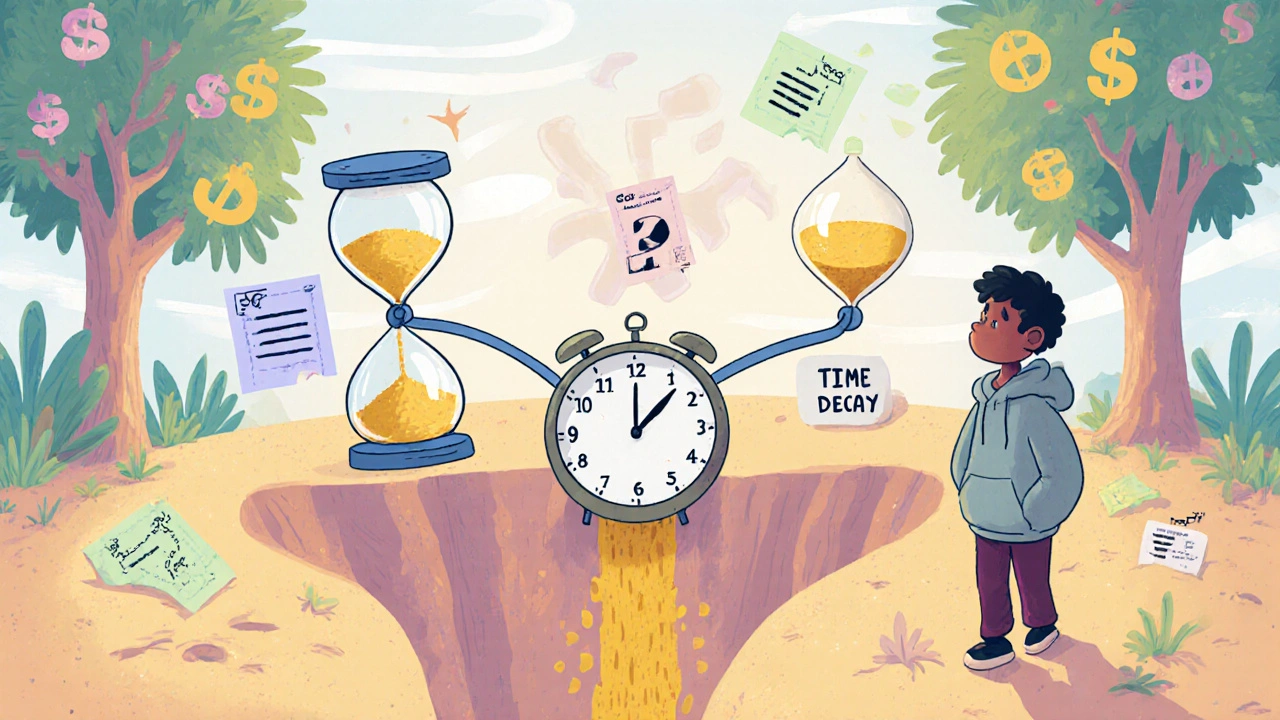Time Decay Calculator
Calculate Your Option Decay
Input your option details to see how much time value you'll lose before expiration
How Time Decay Works
Time decay accelerates dramatically as expiration approaches. For at-the-money options, the last 30 days account for 65-70% of total time value erosion.
0DTE options (Zero Days to Expiration) can lose over 50% of their value in the last two hours. Never hold short options through expiration!
Time Decay Analysis
Note: Values shown are approximate. Actual decay depends on volatility and strike price.
Pro Tip: Experienced traders close positions when they've captured 50-70% of maximum profit, typically with 14-21 days remaining. Holding until expiration reduces your win rate by 30-35%.
Most new options traders lose money not because they pick the wrong direction, but because they don’t understand what happens to their options as the clock ticks down. That’s where option expiration dates come in - they’re not just a date on a calendar. They’re a silent killer of profits if you don’t know how to handle them.
Every options contract has an expiration date. That’s the last day you can trade it or exercise it. After that, it’s worthless. But here’s the thing: the value of your option doesn’t vanish on expiration day. It’s already bleeding out every single day before that. This slow, then sudden, loss of value is called time decay, and it’s measured by a Greek letter called Theta.
Why Expiration Dates Exist
Options weren’t always standardized. Before 1973, trading them was messy - no fixed dates, no clear rules. The Chicago Board Options Exchange (CBOE) changed that. They created contracts with clear expiration dates so traders could know exactly when the game ended. Today, the Options Clearing Corporation (OCC) manages those rules. Expiration dates create fairness. They force a finish line.
For most U.S. equity options, expiration is the third Friday of each month at 3:00 p.m. Central Time. But here’s where people get tripped up: that’s the last trading day, not the actual expiration. The contract officially expires at 11:59 p.m. Eastern Time on Saturday. Your broker may have an earlier cutoff - often 2:45 p.m. CT - to process exercise requests. If your option is in the money but you miss your broker’s deadline, you lose the chance to capture its value. That’s how people lose $2,000 on a trade that looked solid.
How Time Decay Works
An option’s price has two parts: intrinsic value and time value. Intrinsic value is what the option is worth if you exercised it right now. If a stock is at $100 and you own a $95 call, your intrinsic value is $5. Time value is everything else - the extra you paid for the chance the stock could go higher before expiration.
That time value doesn’t disappear evenly. It decays slowly at first, then accelerates like a car going downhill. For a 90-day at-the-money option, you might lose 3 cents a day in the first month. But in the final 30 days? That jumps to 15 cents a day. By the last week, you’re losing half your premium in a single day.
Dr. Robert Whaley from Vanderbilt University says the last 30 days account for 65-70% of all time value erosion for at-the-money options. That means if you buy an option with 60 days to go and hold it until expiration, you’ve already lost most of your premium before the final stretch.
Expiration Cycles: Monthly, Weekly, 0DTE
Not all options are the same. There are three main types, each with different decay speeds:
- Monthly options expire on the third Friday of each month. They’re the standard. Good for swing traders who hold positions for weeks. Time decay is slow enough to let trends play out.
- Weekly options expire every Friday. Introduced to give traders more flexibility, they’re popular for short-term plays. Theta is 3-5 times higher than monthly options at the same strike. You gain speed, but you lose time.
- 0DTE options (Zero Days to Expiration) expire within 24 hours. They’re the fastest, most dangerous. In 2023, they made up nearly half of all U.S. options volume. By Q2 2023, 0DTE options accounted for 73% of Robinhood’s options trades. But 85-90% of them expire worthless. Why? Because time decay isn’t just fast - it’s brutal. In the last two hours, you can lose over 50% of your premium. Market makers hedge aggressively during this time, causing wild swings in the underlying stock. Retail traders often get caught in the crossfire.
LEAPS (Long-Term Equity Anticipation Securities) are the opposite - options with expirations over a year away. They decay so slowly (0.2-0.5% per day) that they’re used for long-term bets or hedging. But they cost way more upfront - often 2-3 times the premium of a monthly option.

Pin Risk: The Silent Killer
Pin risk happens when the stock price closes right near your strike price on expiration Friday - say, $100.02 when your strike is $100. You don’t know if it’ll be exercised or not. If you’re short the option, you might wake up with a stock position you didn’t plan for. If you’re long, you might miss out on a payout because your broker didn’t exercise it in time.
That’s why experts warn: never hold short options through expiration Friday. Even if you’re “sure” it’ll expire out of the money, a last-minute move can flip everything. Fidelity’s data shows 42% of options traders had unexpected assignment issues within three days of expiration. Many didn’t have enough cash to cover the stock if they got assigned.
What Most Traders Get Wrong
Charles Schwab’s data says 65% of first-time traders pick options with less than 30 days to expiration. And 78% of those lose money - on average, 62% of their capital. Why? They think they’re saving money by buying cheap, short-term options. But they’re not. They’re buying time decay.
Another mistake: holding an in-the-money option until expiration to “get the full profit.” That’s a trap. If your option is $3 in the money but still has $0.80 of time value left, you’re leaving $80 on the table per contract by not selling it. You can always buy it back later if you want to re-enter. But if you wait until expiration, that time value vanishes.
Successful traders close positions when they’ve made 50-70% of their maximum profit - usually with 14-21 days left. That’s not greed. That’s discipline. Tastytrade’s data shows those traders win 65-70% of the time. Those who hold until expiration? Only 35-40%.

How to Manage Expiration Dates Like a Pro
Here’s what actually works:
- Set reminders - Use your broker’s alerts. Fidelity and Schwab let you set notifications at 7, 3, and 1 day before expiration.
- Avoid short options near expiration - If you’re selling options, close them by Wednesday of expiration week. Don’t wait for Friday.
- Know your broker’s cutoff time - Check your account settings. If your broker’s deadline is 2:45 p.m. CT and the official time is 3:00 p.m., you have 15 minutes to act. Don’t assume you have more.
- Use the wheel strategy - Sell cash-secured puts on monthly expirations. If assigned, sell covered calls. It’s a slow, consistent income generator built around predictable expiration cycles.
- Check for dividends - If a stock is about to pay a dividend, ITM calls can be exercised early. Your broker might assign you shares without warning.
And if you’re trading 0DTE options? Treat them like gambling, not investing. They’re not for building wealth. They’re for speculation. And the house always wins.
The Bigger Picture
Options volume has exploded since 2020. Retail accounts grew from 7.2 million to 24.5 million. But institutions still use monthly and LEAPS options for hedging. Retail traders? They’re chasing 0DTE and weekly options - the ones with the fastest decay and highest risk.
The SEC and FINRA have cracked down. In 2022 alone, there were 17 enforcement actions against brokers for not properly warning retail traders about short-dated options. The OCC introduced new margin rules for 0DTE options in January 2024 - a move that could reduce retail participation by 15-20%.
But here’s the truth: expiration dates aren’t going away. Time decay is a core part of how options are priced. The Black-Scholes model, the foundation of modern options trading, depends on it. The question isn’t whether time decay exists - it’s whether you’re using it to your advantage or letting it eat your account.
If you’re serious about options trading, stop treating expiration dates like an afterthought. Master them. Plan around them. And never, ever hold a losing position until the clock runs out.
What happens if I don’t sell my option before expiration?
If your option is in the money by $0.01 or more at expiration, the Options Clearing Corporation will automatically exercise it. If it’s out of the money, it expires worthless. But if you’re holding a short option and don’t close it, you could get assigned shares you didn’t plan for - which might require more cash than you have in your account.
Do all options expire on the third Friday?
Most standard equity options do - the third Friday of each month. But weekly options expire every Friday, and LEAPS follow the same monthly pattern but with expirations over a year away. Futures-based options, like those on the S&P 500 index, may expire on different dates tied to the underlying futures contract.
Why do 0DTE options lose value so fast?
Because they have almost no time left for the underlying stock to move in your favor. Theta, the measure of time decay, spikes dramatically as expiration nears. For 0DTE options, over half their value can vanish in the last two hours of trading. Market makers hedge aggressively during this time, causing volatility spikes that often work against retail traders.
Is it better to buy monthly or weekly options?
It depends on your strategy. Monthly options give you more time for a move to happen, making them better for swing trading or income strategies like the wheel. Weekly options are for short-term plays - you need to be right quickly. But they decay faster, so you need tighter timing and more frequent adjustments.
How can I tell if an option has too much time decay?
Look at the days to expiration and the premium. If you’re buying a $2 option with only 5 days left and the stock hasn’t moved much, it’s likely priced mostly for time value - meaning it’s vulnerable to decay. A good rule of thumb: if more than 60% of the premium is time value (not intrinsic), you’re paying mostly for luck, not opportunity.




It’s fascinating how time decay mirrors life in so many ways-slow erosion, then sudden collapse. We spend so much energy chasing immediate gains, just like traders buying 0DTE options, ignoring the quiet, relentless passage of time. The Greeks aren’t just math-they’re metaphors. Theta is the whisper that says, 'You’re running out.' And yet, we keep buying hope wrapped in premium. Maybe the real skill isn’t predicting the market, but learning to accept impermanence. The market doesn’t care if you’re ready. It only cares if you understood the rules before you played. And most don’t. They see a chart, not a clock.
Bro, theta is the silent assassin. You buy a $1.50 call with 30 DTE, think you’re getting a deal, then wake up a week later and it’s $0.40 even though the stock went up 3%. That’s not bad luck-that’s structural. Market makers are pricing in decay like a tax, and retail traders are the ones paying it every damn time. And 0DTE? That’s not trading, that’s slot machines with tickers. The OCC didn’t create this for fun-they created it because institutions needed liquidity. Retail got suckered into the high-frequency junkyard. If you’re not hedging with LEAPS or selling premium with defined risk, you’re just feeding the machine.
Oh sweet merciful god, another ‘educational’ post about how ‘most traders lose.’ Congrats, you just summarized every finance YouTube video from 2021. But here’s the real tea: nobody reads this stuff until they’ve blown up three accounts. The fact that you’re still using ‘time decay’ like it’s some profound revelation means you’ve probably never actually sold a naked put. Real traders don’t obsess over theta-they exploit it. And if you think pin risk is ‘silent,’ you’ve never been assigned 200 shares of AMC at 3:01 p.m. on a Friday while your broker’s system was ‘under maintenance.’ This isn’t investing. It’s behavioral psychology with a Bloomberg terminal. Stop romanticizing the grind. The house doesn’t just win-it prints money while you’re crying over your 0DTE loss.
Thanks for this. Really helped me understand why I kept losing money on weekly options. 😔 I’ll stick to monthly now. And I’ll set reminders. No more waiting till the last minute.